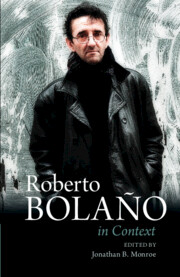Book contents
- Roberto Bolaño in Context
- Roberto Bolaño in Context
- Copyright page
- Contents
- Contributors
- Chronology
- Part I Geographical, Social, and Historical Contexts
- Part II Shaping Events and Literary History
- Chapter 9 France, Spain, 1938
- Chapter 10 The Cold War
- Chapter 11 After the Fall of the Wall: 1989–2001
- Chapter 12 Latin American Literature
- Chapter 13 French Connections
- Chapter 14 German and Russian Precursors
- Chapter 15 After the Two 9/11s: Santiago, 1973, New York, 2001
- Part III Genres, Discourses, Media
- Part IV Aesthetics, Culture, and Politics
- Further Reading
- Index
Chapter 13 - French Connections
from Part II - Shaping Events and Literary History
Published online by Cambridge University Press: 15 December 2022
- Roberto Bolaño in Context
- Roberto Bolaño in Context
- Copyright page
- Contents
- Contributors
- Chronology
- Part I Geographical, Social, and Historical Contexts
- Part II Shaping Events and Literary History
- Chapter 9 France, Spain, 1938
- Chapter 10 The Cold War
- Chapter 11 After the Fall of the Wall: 1989–2001
- Chapter 12 Latin American Literature
- Chapter 13 French Connections
- Chapter 14 German and Russian Precursors
- Chapter 15 After the Two 9/11s: Santiago, 1973, New York, 2001
- Part III Genres, Discourses, Media
- Part IV Aesthetics, Culture, and Politics
- Further Reading
- Index
Summary
This essay looks at the intertextual presence of French literature in Bolaño’s writings, which are famously global in their intersecting plots and cosmopolitan characters. With a focus on the contemporary urban experience, Bolaño elevates the Baudelairean flâneur motif to a global scale, and inherits the Surrealist topos of the city as a place of chance encounters. The quest for a missing or forgotten writer, a structuring device used over and over in Bolaño’s fictions, can be traced back to Surrealist aesthetics, and it also provides a serviceable image of a quest for the validation of narrative. We look at what Bolaño’s novels, in which“visceral realism” defeats the grand 19th-century principle of the well-constructed plot in favor of a loose stringing together of episodic lives, owe to the tradition of Marcel Schwob’s imaginary lives, to Georges Perec’s aesthetics of the collection, the list, and the “infra-ordinary,” and to more contemporary poets of documentary everydayness and small lives such as Pierre Michon and François Bon.
Keywords
- Type
- Chapter
- Information
- Roberto Bolaño In Context , pp. 142 - 157Publisher: Cambridge University PressPrint publication year: 2023

